
Recent Posts
Frame of Reference
How to Play:
- Find an accomplice who does not mind having someone they don’t know take pictures of them.
- Find your player. Make sure that they have not met the accomplice before. Tell them that you are playtesting a new game in which you need someone to take pictures of various objects around town. Once they take a picture, they should send it to you, and they will be scored from 0 to 100 based on how well they took a picture of the object.
- Set up your accomplice near the photo site, doing something innocuous, such as taking a phone call or working on something on their computer.
- Send the player to that site, along with some made-up criteria you’ll be judging their photo by. The true criteria, of course, being whether or not the accomplice is in the photo.
- Once you receive the photo, send the player their score, and ask if they’re satisfied with that score. Once they say yes, tell them to await further instructions.
- Repeat Steps 3-5 with each photo site, or until the Player realizes that the same person has been appearing in most every photo they’ve taken.
Playtesting Experience
After many, many delays due to scheduling issues, I finally managed to track down two friends of mine who don’t know each other; the person who ended up being my accomplice is our very own Timothy Doyle, who you’ll be seeing in quite a few of these pictures. The player was Charlie Liu, a current business major here who I knew from being in the same 12th Grade English Class. The pictures from this playtest are attached to this post.
- Shillman Hall This one was primarily a warm-up. I just had Charlie take a picture of the cat statue out front, with Tim nowhere in sight.
- Forsyth Street More warm-up. This time, flagpoles.
- That one archway outside Snell with all the broken screens inside of it I positioned Tim on a bench nearby, but Charlie never went around to the other side of the arch to actually get a picture with him in it. After around five pictures getting similarly low scores, Charlie gave up. I felt like having Tim move to the other bench would be too noticeable, so I just decided to move on.
- I had Tim sit where he had been on the bench after the playtest, and I myself took a picture of that, just to include in here as an aid in visualization.
- Curry Student Center F1 I asked Charlie to take a picture of the posters from the outside, and had Tim pretend to be busy on his laptop at a nearby table. This one worked like a charm, and had Tim in the shot on the second try.
- Curry Student Center F2 Tim talked to “his mom” over the phone behind a window, and Charlie took a picture of the Husky Statue in front of said window. Couldn’t have gone better.
- Ruggles Station This time, when asked to take a photo of the Customer Service booth, Charlie rotated around it when he was scoring low, which means that he did eventually get a shot of Tim definitely buying a ticket and not just kinda pushing buttons.
- Centennial Quad With this one, I wanted to see just how far I could take this. I had Tim hide behind the 2 of the big 125, and peek out with a grin and thumbs up. Charlie did take the picture of the 125, but he also definitely noticed Tim. And with that, the game was up. I debriefed my player, and we all went home.
Artist’s Statement
AKA “Jackson, why on Earth did you do this?”
I was inspired by games such as Uncle Roy All Around You, and the way it has the Game Master navigate two players out in the field that interact with each other in interesting ways. I wanted to try and create a game that emphasizes just how little we pay attention to our surroundings. The world we live in can be so incredibly distracting sometimes, and everyone’s always got something important that they need to be doing. By making Charlie focus on this one task of photography, he was completely oblivious to the things that the actual people around him were doing. Furthermore, I believe that there’s something to be said about how the points he was getting for the photos didn’t really make sense, and yet he didn’t really question it.
I guess, in the end, what this intervention is meant to show is that as you live your everyday life, you should strive to be aware of the people around you. As you hustle about through your day, don’t forget that everyone around you is doing their own thing as well. Also, be willing to question authority, and to ask for clarification when something doesn’t make sense. Because otherwise, you may end up playing into a completely different agenda without even realizing it.
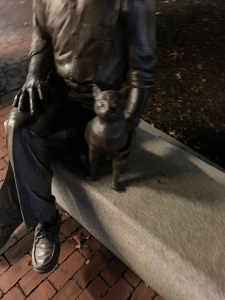

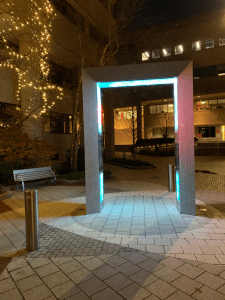
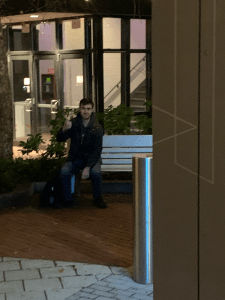
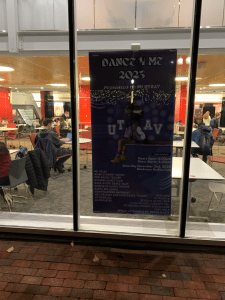
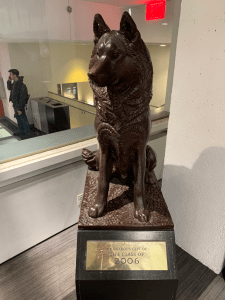

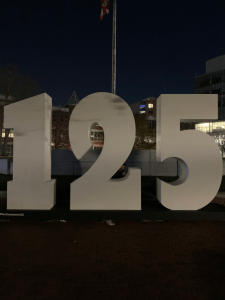
daydream
Artist’s Statement
I have always had the habit of daydreaming random made up fantasy scenarios, to the point I would consider those made up scenarios a small part of my identity. Therefore I wanted to create an experience where this process is visualised. daydream is a text and image based narrative adventure game/visual story aimed to recreate this experience. The game is made up of a series of unrelated short stories/scenarios that the player jumps between randomly. It is slow paced, has no ending, with the “goal” being to simply experience the stories.
Some aspects of daydream can be considered to be appropriation, as a significant amount of my daydream scenarios are heavily influenced by the media I consume, especially in the emotions they made me feel, and the immersion I felt while reading/watching/playing/listening into those made up fantastic worlds and the stories that happen within them. These influences are reflected in both the writing and artwork, where I included small bits of paraphrased lyrics and titles of my favorite songs; and that my art style is very draws heavy inspiration from backgrounds and scenery of anime and movies made by Studio Ghibli, Kyoto Animation and Shinkai Makoto. Of course, my creative inspirations is only part of the game, the main theme I’m trying to capture here is my creative process: jumping to and from very different ideas, trying to capture them before they slip my mind. I also tried to vaguely depict some of my artistic frustrations and general regrets in some of the stories, as well as my hopes to growth as an artist.
One more thing I tried to convey with daydream through the writing and artwork is a general atmosphere or “vibe” of peace, calmness and tranquility, both as a personal preference of storytelling, but also to create break from the chaotic and extremely fast paced real world with this game. Additionally, I also wanted to convey a sense of slight sense of somberness and melancholy in most of the short stories, but also to instill a concrete ambience of hope, in a “brighter days are ahead” kind of way. I think I did this both because of my narrative preference, but also because I feel like the real world has been harsh and depressing, but media and creative outlets such as creating art offers an escape and makes me feel healed. While I am unsure if I can get these feelings across with the game, as it is quite possible for players to feel bored given the slow pacing of the game, I do still think daydream can resonate with certain players.
Finally, I want to present a lyric from a song by my favorite artist: Get Your Wish by Porter Robinson
The work that stirred your soul
You can make for someone else
I hope daydream and the other games and artwork I will make in the future can inspire others to create art, just like how I was inspired to daydream, to create worlds and tell stories of my own.
Documentation
Sample gameplay video:
Credits and Game Download
Game engine: Twine 2
Writing and artwork: made by yours truly
Download here, extract and open the HTML file to play
“Childhood”
Overview:
‘Childhood’ is a short abstract game in which you play as a small green dot collecting other, smaller red dots. The controls are as minimal as it gets- simply move your mouse to drive the green dot agonizingly slowly towards each dot with no real purpose or goal aside from collecting dots to earn points. At the top of the screen is a clock that starts at zero and counts up as you play, giving the impression that the game simply never ends. The twist? ‘Childhood’ does end, but it takes seventy-five years of real time to complete (that is, if you were to play it normally.) After a few minutes, you are introduced to the main mechanic- you have the ability to hold the spacebar and fast forward time. Doing so allows you to see the game develop into something different as the hours, days, and years fly by in a matter of seconds. Slowly your objective morphs from simply ‘collect dots’ and becomes increasingly complex and hectic. It’s up to the player to decide how long they want to play each section of the game, or if they’d like to skip it almost entirely and see the next section.
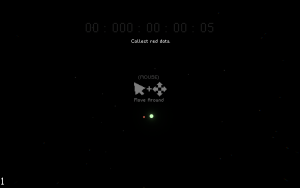
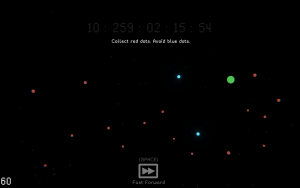
Artist’s Statement:
This game began as a simple, and probably very relatable, thought that I had- “I really miss being a kid. Things were so simple back then.” Becoming an adult is pretty fun, don’t get me wrong, but when you stop and think about how easy and fun your life was as a little kid compared to the stress and responsibilities of college life- homework, job search, finances, etc… It seems like that period in time is almost idyllic. The funny thing, of course, is that when you are living that part of your life, you pretty much want nothing more than to grow up as fast as possible. Each new age seems like a milestone, something to ‘conquer’ and be treated more like a grown-up. From this juxtaposition the idea took shape- life is like a game that seems boring while you play it, but in retrospect, you wish you had stopped and enjoyed those ‘boring’ moments more than you really did. Presentation-wise, I took inspiration from Art Games such as “The Marriage,” which sought to represent the concept of cooperation and role within a marriage using abstract visual art and simple gameplay. I found this to be very effective in bringing my own idea to life- wanting to use things like the size of the player and their movement speed to imply things about the different stages in a person’s life.
If you’re reading this, I think you should really just play the game before I spoil everything- but I’ll go ahead and explain my thought process behind some of the mechanics/design choices and what they were meant to represent. The clock, of course, is a human lifespan (that is, the average American lifespan is about 75 years.) I thought it would be really interesting to be able to experience an entire life on ‘fast forward,’ watching them slowly get bigger (grow up), get faster (have more energy and drive), before finally regressing (getting old) and coming to a complete stop at the end of their life. The various stages were meant to increase in complexity, and despite being more ‘engaging’ than the gameplay at the very start (which represents a person’s childhood), will quickly grow overwhelming and impossible to manage during the final stages in which you are effectively forced to lose all your points.
Thoughts:
I’m mostly very happy with how it turned out- I think the visuals and sound design were especially good. I think if I had had more time, I would have liked to improve the gameplay progression a bit more to push the ‘overwhelming’ feeling I was going for towards the end of the game. What I have now is successful, but I think that it still feels more monotonous than it does stressful in the final stages and I could have improved that design.
Tools/Assets used:
- Unity Engine/Visual Studio w/ C# language
- Aseprite (UI graphics)
- dafont.com (game font)
- freesound.org (BG music & sound effects, all were creative commons 0)
Download on Itch.io:
https://ragefordragons.itch.io/childhood
(You will need to use the password GAME1850 to access the page.)
A Long Respite
Artist’s Statement:
I got the initial idea for this project by looking at what it meant to be an artgame. After reading John Sharp’s, “Works of Game” I was inspired by his description of an artgame game. I understood that artgames use the innate properties of games like interactivity, player goals, and game mechanics to create expressive play experiences that explore metaphysical questions around life, ethics, and aspects of the human condition. Unlike normal games, the systems in artgames tend to model ideas and concepts rather than phenomena from the physical and social world. This concept spoke to me because I have long been critical of the way the current gaming landscape tries to force an experience onto its players. Many modern games explain every single thing from every control to every facet of their narrative. I wanted to get away from that by creating an artgame that centered its interactivity, player goals, and game mechanics to give the player an experience that I found lacking in the modern gaming landscape. I believe that the modern gaming landscape lacks many games that try to get the player to experience a narrative without the use of any words. Even in the case where games do create a narrative without words they often rely on out-of-game descriptions, cutscenes, or endings to show the player that there is a deep narrative present. I wanted to get away from all of that and present the player with an experience and environment that has no given explanation. It’s up to the player to discover everything, end when they want, and interpret the game in their way.
This project relates to a few of the artgames discussed in the readings. One of the games that relates is “The Marriage” by Rod Humble. “The Marriage” does not explain its mechanics, message, or narrative to the player and instead leaves it up to the player to discover and interpret for themselves. The mechanics themselves are simple yet the combination of the mechanics and how the squares react are what make the game so interesting to play. The readings also stated that it was unlikely that people would come out of the game with the message that the creator intended. This game is similar to what I wanted to do with my game because I want the player to experience the game without being told what to do. If they come out of the experience with a different meaning than what I intended that is perfectly fine and even encouraged by me because it will make conversations about my game more interesting. My game also attempts to use its subtle mechanics to help paint a narrative. The game also relates to “Papers, Please” because it has a very stylized art style and ends when you want it to end.
A lot of the other influence and intention is explained in the “Documentation / Process” section below.
Documentation / Process:
This section will spoil a lot of the intent behind the game so I would only read this part if you do not want to experience the game in the way it was intended to be experienced. After I decided on how I wanted to convey my narrative, I then wanted to figure out what I wanted my narrative to be. I decided that I wanted to have my narrative be about a fallen samurai because I had Japanese history and the game “Okami” on my mind at the time. I didn’t want to tell a sad story though, instead, I wanted my narrative to be whimsical and use VFX and audio as well as a well-crafted level to tell its story. This along with inspiration from the Xenoblade Chronicles series gave me a start on what I wanted the level to look like. Xenoblade Chronicles 1 and 2 both feature ethereal, majestic trees that I wanted to try to replicate. I thought that a magical-looking sakura tree would be the perfect place to bury a samurai. Furthermore, a well-respected and battle-tested samurai would likely want to be buried in a peaceful spot where they could be one with nature. This helped me settle on the island surrounded by water and helped me pick the sounds that I wanted to incorporate. I added wave noises that increase in volume as you approach the water as well as the song “Satorl Marsh (Night)” from the Xenoblade Chronicles Definitive Edition soundtrack. I felt that this song would be the perfect choice for the game as it strikes an immaculate balance between Zen and whimsy. The song is one of my favorites and often makes me more in tune with my emotions like I hoped it would for the player. This song choice also helped inform my next decision which was to add a day and night cycle. I wanted to make it feel like even though you were dead the world kept moving, time kept moving. The area of Satorl Marsh (where the song is from) is also extremely interesting as it is unassuming during the day, but at night the trees start to glow, ether starts to float into the atmosphere, and the music gets intense. Using this inspiration I created the ether particles that move into the air to capture the sense of whimsy and beauty that area had. These visual effects also make the island feel spiritual in a way like the tree and particles make the island seem like a place where spirits would want to rest. This idea informed a lot of the decisions related to my mechanics. The spiritual feel of the island made me want to make the player character the spirit of the dead samurai who was chained to this island after their death. To accomplish this I started by creating a movement system with low-gravity physics. This was in an attempt to make you feel floaty like a ghost or spirit. I also added a very high jump/float if you press/hold the space bar to increase this feeling. Additionally, I removed the player’s shadow and made them be able to walk through the sword and tree showing that they do not have a physical form. Despite all of this, I still felt like it would be hard to tell who you were. To fix this, I made it so that particles of a humanoid figure follow where you were at night. This makes it so that the player is rewarded for looking around and that you can see that something ghostly is going on. Lastly, to accomplish the feeling of being chained to the island, I wanted to make it so that the farther away you got from the katana the slower you would move. Nothing is stopping you from moving far away, but it is clear that the island wants you to rest in peace.
Through playtesting, I learned that the tree trunk and the grass were distracting from the overall Zen and carefully crafted feel of the level, so I tried my best to improve them. I also learned that players had extremely different interpretations of what was happening, ranging from “the island is pretty” to “I liked that I was a ghost samurai.” I think the thing that I heard that made me feel like this was successful was when a playtester told me that they enjoyed that they had to think through the game and they liked that nothing was told to them.
Links:
- Game: https://drive.google.com/file/d/12Bx_Z0xHtnAee49fLxPxJAqhLteOa47t/view?usp=sharing
- Asset Links:
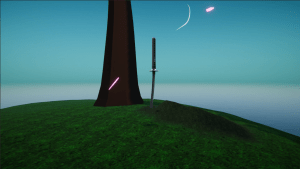


Art vs War
Background:
In 1916, exiled Zurich artists such as Hugo Barr, Amy Hennings, Tristan Tzara, Hans Arp, Richard Husenbeck, and Sophie Thorber formed a literary society in the local Hotel Voltaire, where they expressed their distaste for the war and the values that spawned it, through discussions of artistic topics and performances.
Requirements: 4-5 players, Dice
Basic rules
Description: This is a board game that requires 4 players. Each player represents a side, they are Military, Workers, Merchants, and Artists. Each side will have 20 million population. If a player’s population is eliminated that means its side is out of the game. If there is more player, they will automatically be civilian side.
Basic Rules: Roll the dice to decide who to start with, with the order of players after that going clockwise.
There will be four identity cards representing the different powers on the field, and each person draws one at random after it is disrupted face down. After that, you will receive your population, and each player will have a total of 1 card with a population of 10 Million, 1 card with a population of 5 Million, and 5 cards with a population of 1 Million. Players will need to place these population cards face down in random combinations around the identity cards to avoid being seen by other players. Players can trade resources with each other (consensual) or money (players can use money to buy other goods and the person they are trading with can’t refuse), or attack (artists can’t attack).
Warmonger: This is a power ruled by war-mongers who are passionate about selling nuclear weapons or using them to bomb other countries. In the game, warmongers will bring their nuke at the start of their turn, and automatically get one every 3 turns thereafter. Nukes can be traded and used to attack other countries, but only once every two turns. Nukes can be traded and can be used to attack other countries, but only every two turns. two ore and one money can also be spent to actively build nukes. warmonger needs to actively eliminate at least two forces to win.
Merchant: merchants have a great deal of wealth, and they oppress their workers and win through various means. Merchants have six money cards at the start of their turn and gain two money cards every turn thereafter. Money cards can be used to force the purchase of nukes, artwork, and ore. However, only one type of material can be purchased from a single player per turn. The merchant must eliminate the worker force himself to win, and if the worker force is eliminated, the merchant loses his solo victory and has the option of joining the artists in the fight against the warmonger.
Worker: Workers who are hard at work mining ore, and who resent the oppression of the merchants and rebel against them. At the start of their turn, workers have three Ore cards. Every two turns thereafter, the worker mines two Ore Cards. Ore cards can be traded for nukes. They cannot be actively sold but can be purchased by any other player. The worker wins by actively eliminating the trader, and if the trader is eliminated by the warmonger, the worker has the option of surrendering or joining the artist’s side.
Artists: Artists are a group of peace-loving idealists who fight against the warmongers by creating artwork that can’t be attacked by nukes wherever it exists, and the Artists come with two pieces of artwork to start with. Artists get one artwork every 3 turns, and artwork can be sold or purchased by the player. Artworks can be placed on any of the player’s Population cards to protect against a nuke attack, but they cannot be stacked on the same Population card, and a maximum of two Artworks can be used on the field at the same time. Extra artwork can only be stored and not placed on Population cards. The Artist wins if the warmonger is eliminated, but the Artist cannot use or buy nukes.
Special condition: When there is a fifth player or more on the field they are automatically in the civilian camp. Civilians cannot create any resources, open with 10 million population, and can generate a new 1 million population each turn. Population can also be traded for resources or bought and sold. However, civilians must not have a minimum population of less than 3 million or they will be considered eliminated. Civilians can choose one of the four camps at the beginning of the round, but this choice cannot be made known to anyone else. If the chosen camp wins, the civilians win together. If the chosen camp is eliminated, the civilians have another chance to roll the dice and decide on a number. If the result is the same as the dice roll, the civilian camp will inherit the abilities and victory conditions of the chosen camp, but not the population or resources, and will lose the civilian camp’s original abilities. If it does not succeed then it will be eliminated together.
When one phases out another side, that side will inherit the abilities of the phased-out side, provided that civilians have not replaced the original side
- Price list:
1 Ore = 2 Money
1 Artwork = 3 money
1 Nuke = four money
1million population = 6 money - Resource Exchange
3 Ore can be exchanged for 1 Nuke
1 artwork for 2 ores
6 million people for a nuke
4 million people for a work of art
3 million people for a mineral card.
Two million people for one money.
Playtest:
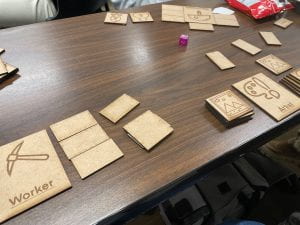
I realize that when a set of rules is set up, it works in theory. But when implemented in reality it can be so irrational and unworkable. I got a lot of different feedback from players, so after playtest I improved the rules and added new ways to play.
artist statement:
I started out creating this game originally when I learned about Dadaism and the story behind it in class this semester. I was inspired by the work of many artists against the war, such as George Grosse’s Metropolis. I was drawn to these anti-war pieces and was intrigued by the way they satirized war. I believe that people should live in peace with each other, eliminate prejudices, and cooperate. This is an idea that many Dada artists want to convey.
When I realized that there are still many people in the world suffering from war I decided to make a card game related to war. Because the game allows players to engage in real competition, it has a different advantage than just artwork.
My game contains four camps, they are the warmonger, the merchant, the worker, and the artist. Reflecting some groups in the real world, they check and balance each other, but can’t live without each other. Each camp has its purpose to achieve. But I designed the warmonger to be more powerful because this is the cruelty of modern war, the one who owns the weapon has the real power of speech. The artist camp, on the other hand, represents many peace-loving idealists who may be fighting back hard but can’t change anything. But the fact that paintings can be traded in the game is also my way of satirizing the use of art as a money-making machine by certain artists. I hope that when players play my game, they can feel the cruelty of war, and the feeling of powerlessness when facing a really powerful opponent. At the same time, it can draw attention to and reflect on war. Of course, in addition to these core ideas, I also hope that players can bring in characters and win the game through their own decisions and thinking.
Sources: some icons are from “thenounproject.com”
Apex Legends:Happy Birthday Song Challenge
Requirments: Any device that can play apex legends
For my Intervene project, I had chosen the battle royal first person shooting game Apex Legends as my subject of intervention. In this game, I when to both the battle royal mode and team death match mode. In this game, people barely turns on their microphone before the game actually started. So in the beginning of every match, I typed something like:”Hi guys, its my birthday today, can yall sing happy birthday to me?” I would like to see how my teammates react to my request. I want to interfere with their gaming experience through such seemingly unreasonable demands. At the same time their response interferes with my gaming experience and the results of my experiment. So I played around 10 matches in total and I only edit the 5 games out of it, because it seems like no one actually cares about their temmates birthday or they just ignore my request. Some of them did response but instead of singing the happy birthday song they typed Happy birthday in the chat. However in one match there was someone who actually sangs happy birthday song to me, I was so impressed.
Artist statement:
I embarked on an unconventional artistic intervention in a game world where strategy, skill, and quick reflexes are the main elements in a tense and exciting apex legends matchup. My project was unassuming but impressive, causing my teammates to pause in their pursuit of a game win to participate in a birthday sing-along in honor of my birthday.
The purpose of this intervention was to inject humanity and joy into every competitive and stressful online multiplayer game. It challenges the conventions of gaming interaction, blurring the lines between the battlefield and the shared space of celebration.
At the same time I see it as an exploration of human connection in the digital world, where the act of singing Happy Birthday is one that is universally recognized as a symbol of joy and solidarity, turning the digital battlefield into a vehicle for celebrating my birthday. I think this is similar to the work “Rope” in that my teammates are strangers matched through a computer algorithm, and they are not obligated to sing along with me for my birthday. rope’s idea is also to challenge the idea of how people get along with each other, and to forcefully bind two people together in a certain way (they use rope, I use the birthday song). The idea of rope is also to challenge different people to get along with each other in a certain way (they use a rope, I use a birthday song), and to accomplish seemingly impossible challenges until they reach a certain state of harmony, where human emotions can be transmitted to each other in the most unlikely of circumstances. What these two projects have in common is that they challenge the traditional way of being together, both in life and in games.
Find The Strongest Heart:
Equipment:
computers with Overwatch
Something can measure heart rates/ blood pressure (apple watch, phone…)
need 2-3 players
Rules:
Players need to measure their heartbeats before and after a regular Overwatch competitive gameplay. Use the heart rates after minus the heart rates before to get the current score of players. The player with the lowest score wins the game.
Artist statement:
Overwatch is a toxic game that often leads players to experience heightened emotions during the gameplay. Defeats in the game can trigger frustration and anger. As they get rages, their blood pressure or heart rates may increase. Therefore, the person with the lowest score could be considered as the calmest. By rewarding the player who maintains the lowest increase in heartbeats, this game encourages players to stay calm and despite the toxic gaming environment. It challenges the notion that winning or losing a match is the only measure of success in gaming and suggests that emotional control is equally valuable.
Before playing:
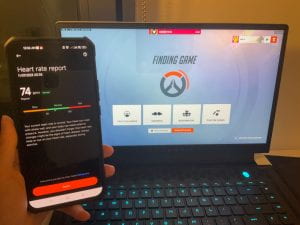
second round:

lose the game:
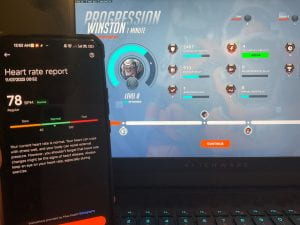
After losing for all night! (still the same heart rate)
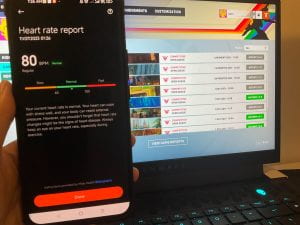
Result:
I tried to borrow my friend’s watch, but we got some time conflict so I can only use the app on my phone to measure the heartbeat instead. I played this game several times myself. But measuring with my phone didn’t work as I expected. My heartbeats were 76 before playing. However, when I measured the heartbeat after an annoying and frustrating round, it was still around 80. I tried a few times and played four games in total, but the heartbeats just stick with 70 – 80. Maybe in the future, I could try to measure the heartbeats with other equipment. I found this game shares some similarities with Yoko Ono’s cut piece in that both projects explore vulnerability and emotional states. While “Cut Piece” focuses on physical vulnerability through cutting clothes, this game focuses on emotional vulnerability while playing Overwatch. On the other side, because Overwatch is such a toxic game to play, the players may face emotional stress and strain. And that can connect to Chris Burden’s “Doomed” which challenges limits of the body and personal endurance
How to Make Friends on Valorant
For my project, I chose to intervene on a game of Valorant Deathmatch. Rather than determining success based on kills within the match, I would try to get other players to not kill me, whether it be they bad at the game, or they genuinely don’t want to kill me. Through my iterations, I realized that there are certain behaviors that I must adopt to get this message across. The first run that I have done with this idea didn’t go as well since the message didn’t seem to get across that I am trying to be a pacifist. After throwing myself in front of people with a melee weapon as well as use the in-game mechanics to get the point across. In the end, I even gained some people that ended up protecting me with in the match, killing others that would end up shooting at me.
Artist Statement:
The initial inspiration that I got for the project was from the Barbie Liberal Organization that was shown in class. I found it intriguing that altering the standards for a Barbie doll could lead to a message being pushed across as well as bring joy to those that comes into contact with it. Generally, activist movements tend to receive some form of backlash from the community, but BLO seemed to sparked more laughter compared to the anger that I was anticipating. I wanted to spark this joy within the FPS community, which is known for the toxicity and the negative player-base. By bringing this little wholesome moment to the game without any expectations, I hoped that I would be able to remind others that the experience of fun that players can have is up to them.
The behavior that I adopted to get the point across to other players was that similar to Yoko Ono’s cut piece. It was meant to make myself seem vulnerable to others within the game, that my intention is not to follow the standards that they are used to. By letting my fate be decided by other players within the game, it was fun to see how varied the reactions were. Some were caught off guard at first and decide to play along, while others killed me anyways.
Overall, it seemed that my point to bring fun back into the genre worked as it seemed like the players that played along enjoyed the concept enough to continue with it for the entirety of the match. If I were to bring this into other FPS games or game modes within Valorant, I hope to be able to keep the idea that winning or losing the game wouldn’t matter as long as the players are having fun within the game. As a result, by making these team-based games to be as enjoyable to others should be more prioritized as opposed to relentlessly putting others down for the self-satisfaction that one is better at the game compare to others.
Clips from playtests of this project:
https://youtu.be/ZioWrg21eU8
Steal the Beat
All players start with the same 30 second music video clip. The first one to upload it to YouTube without their copyright detection recognizing the song wins. They may use any means necessary to do so – distorting the video, distorting the audio, rerecording parts of it, renaming the upload, etc. Anything is fair game as long as the clip stays recognizable.
You will likely need a 3rd party judge to determine if the video clips are intact enough to be valid.
When you are done, share your strategies in hushed whispers where YouTube and copyright holders cannot hear.
To playtest this game, I played it single-player with Mariah Carey’s “All I Want For Christmas Is You”. You can see my results in the video below.
Each attempt took about 10 minutes to render and export, and YouTube recognized the copyrighted material in attempts 1 and 2 in less than 20 seconds. Whether or not my third attempt counts as “intact” is up to your interpretation.
Artist’s Statement:
This game ended up significantly harder than I expected. To start, you can only even play it if you have the software and knowledge to edit video and audio sufficiently. I used Adobe Premiere in my playtest, but it could be possible with entirely free software as well. Once you actually do find some players and start, the game is very slow. Waiting to render and export every attempt becomes tedious quickly. As you can see in the video, I had to distort the audio and obscure the video very severely to be able to upload it. The game may be easier if you play with a less popular song, where the copyright is enforced less harshly.
I was inspired by Jennifer Gradecki and Derek Curry’s intervention in algorithms and computer systems. Their artwork is very concerned with algorithms and data processing, and how they are applied and misapplied in our modern era. I am fascinated with copyright, and have seen various creators on YouTube employ different strategies to play short relevant clips of copyrighted material in their videos. I figured this copyright dodging could make an interesting creative game. There are many ways to go about avoiding YouTube’s copyright detection, but in practice you realize how difficult a task it can truly be.
Part of what I wanted to do with this was to teach players how to get around YouTube’s system, and help them firsthand understand what makes YouTube stop recognizing the copyrighted material. This desire to teach is also why I urge players to spread the information they learned, without telling copyright holders. I think the current systems of copyright and its enforcement are detrimental to art, and the allocations of fair use are insufficient. I wanted to subvert this system and intervene in it. By playing the game on YouTube, players directly interface with perhaps the most-used copyright enforcement algorithm on the entire internet. One thing the game does very well is show how difficult it is to subvert YouTube’s automatic detection. When copyright laws were written, such algorithms did not exist, and copyright infringement had to be enforced on a case-by-case basis. This was slower, but allowed more edge cases to slip through the cracks. Nowadays, there is no way to slip through unnoticed when YouTube checks every video for copyrighted content. Sometimes the copyright holder chooses not just to take any monetization on the video, but to block it entirely. Jennifer Gradecki and Derek Curry’s Boogaloo Bias artwork (among several of their other works) is very concerned with false positives in automatic detection algorithms. This is a huge issue in YouTube’s copyright detection system that I wish my game did more to address. Perhaps one could play to try and twist one song to be recognized as another, but that is a game for another day.
A Critique on Grades
For this project I wanted to design an experience that would make the people participating break their typical behavior. Through schooling we are taught in a way to pass test, not in a way that teaches us things for long term memory. I wanted to create a test that would incentivize the users to abandon the exam for some other behavior, so I created an image, like a “wheres waldo” where the test takers had to memorize things in the image then answer questions about it. (see images and quiz below).
Because creating the image would take quite a while, the first iteration of this project for me was playtesting the idea with other people. I explained the concept of my project and wanted their input for if they thought it would actually work. From the few people I described it to, they agreed that it was an interesting idea however many people expressed concern that people would be unlikely to take the action I expected. I agreed and considered what I could do to make this idea more obvious but still subtle enough that it would still be the playtesters on choice to take action. I decided that I would test this on my roommates and depict our house in the image so they were already familiar with it. I showed a candy bag in the kitchen in the image and the test takers in the living room.
I noted to the players before the start of the “exam” that only the person with the best score would get a piece of candy. Despite the playtesters noticing that the bag of candy was in the kitchen, after they had finished the ‘exam’ they explained that the thought of leaving the “testing room” would never have crossed their mind, nor do they think there was anything I could have done to change their behavior.
One funny note, one of the testers was so conditioned by exams that they put their name at the top of the page despite me not adding that as a prompt on the exam page. (there were only two of them and they were writing in different colors)
Ultimately, I think most people would show the same behavior as my roommates did if placed in the same position. However, despite this intervention failing, in some ways I think that it actually is more successful because it failed, showing the testers how schools have conditioned them in such a way.
This artwork was somewhat inspired by the Barbie/G.I. Joe swap, in that some experiences are not always as you expect them to be from their surface image. Like the Barbie/G.I. Joe swap, I wanted to create an interaction with the users that would make them reconsider their behavior with familiar items/experiences, and hopefully make them see these experiences differently in the future.
Image given to testers:
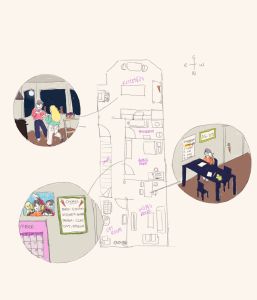
the testers studying the image:

the testers taking the test:
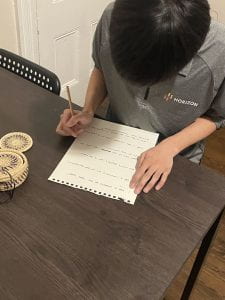
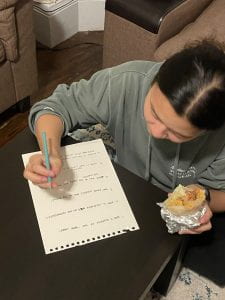
Quiz questions:
- who is in charge of the “bath” chore?
- who is currently #4 on the leaderboard?
- how many carrots are in the image?
- what day of the week was the 1st of the month?
- What is the current time in 24 hour time?
- Where is the bed located in Anna’s Room? Give your answer in cardinal directions.